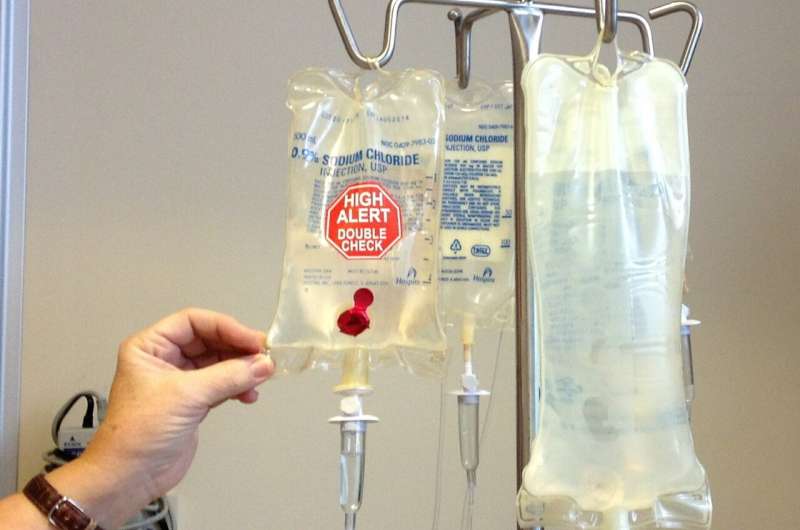
Australian nanomedicine researchers have come up with a new approach to solving a decades-old clinical problem: getting treatment drugs to act selectively on cancer cells in the body. Published this week in Science Translational Medicine, the research paves the way to safer and more effective treatment options for children with aggressive blood cancers, and potentially other types of cancer as well.
Chemotherapy is the mainstay of treatment for leukemia, the most common blood cancer in children. However, while chemotherapy can be very effective for certain types of leukemia, it is not as effective for some other types, known as "high-risk" leukemias. Treatment for high-risk leukemias generally involves high doses of toxic drugs that flood the body, indiscriminately affecting cancer cells and healthy cells alike. This often leads to severe side effects, as well as lifelong health issues in survivors.
"Finding a way to make treatment drugs act more selectively on cancer cells is the key to improving treatment success while reducing toxicity in children treated for high-risk leukemia," said Professor Maria Kavallaris AM, Head of the Translational Cancer Nanomedicine theme at Children's Cancer Institute, who led the research. "By specifically targeting leukemia cells, we can make treatment more effective, as well as much safer to use in children."
In the newly published research, scientists at Children's Cancer Institute and collaborating organizations used a special formulation of the cancer drug, doxorubicin (Caelyx), in which the drug is encapsulated in tiny particles called liposomes. To this formulation, they added "bi-specific antibodies"—antibodies capable of recognizing and attaching to the drug at one end and to cancer cells at the other end, effectively acting as a bridge between the two. Known as a "targeted drug delivery system," this acts to deliver the drug to its target, in this case leukemia cells, where the drug can do its job and kill the cells.
"What is particularly useful about this new approach is its flexibility," explained lead author, Dr. Ernest Moles, Research Fellow at Children's Cancer Institute. "We can use this system to target any leukemia, including the high-risk subtypes that are killing Australian children every year. Rather than having to design a completely new therapeutic each time, all we need do is change the antibody bridge, and we can target the same drug to any child's blood cancer."
"What's more, this approach could allow us to counter drug resistance in an individual patient. If the cancer cells in a child try to evade chemotherapy by altering their cell surface, we can modify the targeted drug delivery system so it is able to recognize that altered cancer cell. There will be no easy escape."
The new approach was shown to work well not only in leukemia cells grown in the laboratory, but also in living models of the disease. In these models, the targeted drug delivery system was found not only to reduce the amount of leukemia, but also to significantly prolong survival—in some cases, up to four-fold.
The researchers believe this same approach could be used to improve the selectivity of a whole range of new-generation therapeutic agents, not just chemotherapy drugs, opening the way to offering children alternative therapeutic options that are much safer than those currently on offer. They are also excited about the potential contribution it could make in the dawning era of precision medicine.
"In the future, it may be that each child diagnosed with leukemia can have their treatment targeted to their specific subtype, based on the analysis of a blood sample," said Professor Kavallaris.
"We believe the controlled targeting of nanotherapeutics represents a real milestone in the treatment of childhood cancers, and we're very optimistic about where this could lead to."
Matt Weston and his son Jacob, who is currently being treated for acute lymphoblastic leukemia, know all too well the significance of this research. "I've followed this research project closely, and I've been absolutely blown away by the work of Maria, Ernest and the team at Children's Cancer Institute," said Matt.
"Having experienced firsthand how toxic the chemo treatment is through my son's journey, I could tell you some horror stories of the side effects even with a standard risk diagnosis. For those with high-risk leukemia, not only is the treatment far more toxic, but their chances of survival are much lower as well.
"I think about those children and their families all the time, and to know that we are closer to improving the treatment, reducing the toxicity, and improving their chances of survival gives me great hope."
More information: Ernest Moles et al, Delivery of PEGylated liposomal doxorubicin by bispecific antibodies improves treatment in models of high-risk childhood leukemia, Science Translational Medicine (2023). DOI: 10.1126/scitranslmed.abm1262. www.science.org/doi/10.1126/scitranslmed.abm1262
Provided by Children's Cancer Institute Australia
Citation: Australian nanomedicine research into drug delivery system a 'milestone' in the treatment of childhood cancer (2023, May 17) retrieved 17 May 2023 from https://phys.org/news/2023-05-australian-nanomedicine-drug-delivery-milestone.html
This document is subject to copyright. Apart from any fair dealing for the purpose of private study or research, no part may be reproduced without the written permission. The content is provided for information purposes only.
https://news.google.com/rss/articles/CBMiUmh0dHBzOi8vcGh5cy5vcmcvbmV3cy8yMDIzLTA1LWF1c3RyYWxpYW4tbmFub21lZGljaW5lLWRydWctZGVsaXZlcnktbWlsZXN0b25lLmh0bWzSAVFodHRwczovL3BoeXMub3JnL25ld3MvMjAyMy0wNS1hdXN0cmFsaWFuLW5hbm9tZWRpY2luZS1kcnVnLWRlbGl2ZXJ5LW1pbGVzdG9uZS5hbXA?oc=5
2023-05-17 18:00:04Z
CBMiUmh0dHBzOi8vcGh5cy5vcmcvbmV3cy8yMDIzLTA1LWF1c3RyYWxpYW4tbmFub21lZGljaW5lLWRydWctZGVsaXZlcnktbWlsZXN0b25lLmh0bWzSAVFodHRwczovL3BoeXMub3JnL25ld3MvMjAyMy0wNS1hdXN0cmFsaWFuLW5hbm9tZWRpY2luZS1kcnVnLWRlbGl2ZXJ5LW1pbGVzdG9uZS5hbXA
Tidak ada komentar:
Posting Komentar